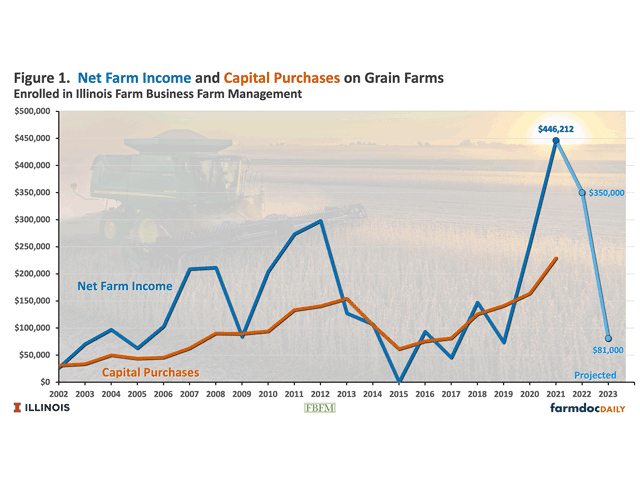Crops Cost Crunch to Persist Into 2023
Acre of Corn Cost 19% More to Raise in 2022, USDA Sees Little Change in 2023
MT. JULIET, Tenn. (DTN) -- Raising a corn crop cost an average 19% more in 2022 than in 2021, with higher fertilizer, chemical and fuel costs largely to blame.
USDA released updated estimates on Tuesday showing it cost an average of $882 per acre to raise corn and $598 per acre to raise soybeans.
DTN Lead Analyst Todd Hultman said he was initially surprised fertilizer expenditures weren't higher, even though USDA said they increased 65% year-over-year.
"If you compare spring of '21 to spring at '22, nearly all the fertilizer prices -- potash, urea, anhydrous -- they were all roughly double what they were the previous spring," he said. "But, as I got to thinking, a lot of guys did put on a fall application before 2022, and for those guys, they didn't get the biggest part of the increase in cost."
Farmers also saw corn prices going up and pre-booked their needs for 2022 on the assumption that input prices would follow commodity prices higher.
Chemical expenses climbed 24% from 2021 to 2022, while fuel increased 44%, a little less than Hultman's early estimates.
"When it comes to the bottom line, the $882 per acre cost for growing corn really was not far from my early estimate of $900 when we were talking about this at planting time," he said, adding that USDA's estimate is probably pretty close to the mark. You can find USDA's detailed estimates here: https://www.ers.usda.gov/….
P[L1] D[0x0] M[300x250] OOP[F] ADUNIT[] T[]
Given USDA's current national average yield estimate of 172.3 bushels per acre (bpa), that means it cost a farmer $5.12 to produce a bushel of corn. Using a national soybean estimate of 50.2 bpa, farmers spent about $11.90 per bushel.
"There's always a big variety because different parts of the country have different costs and yields," Hultman said. "So, this is always just a real big rough national estimate we're talking about."
Given current market prices, there's plenty of room for profitability on the 2022 crop.
In a recent Farmdoc Daily post, economists Gary Schnitkey, Nick Paulson and Jim Baltz estimated that the average Illinois grain farm will have a net income of $350,000 in 2022 with higher commodity prices more than offsetting cost increases. They use an average price of $6.40 per bushel of corn and $14 per bushel of soybeans in their estimates. You can find those details here: https://farmdocdaily.illinois.edu/….
"This year, fortunately, it looks like it's going to work out overall pretty well. But, you know, for next year, I think we're just one hint of good weather away from having a significant drop in our corn and bean prices," Hultman said. "So, I think that makes this year a little more nervous even than it was last year."
USDA's forecasts for 2023 expenses are similar to this year at $870 per acre of corn and $591 per acre of soybeans. The agency's economists see fuel and fertilizer prices falling back a bit, which Hultman said isn't surprising since most fertilizers have backed off recent peaks and companies seem to be taking logistic and supply chain issues seriously.
For most farmers, spending $212 for fertilizer for an acre of corn comes with a hefty dose of sticker shock.
"Nobody likes writing those big checks in the spring because you're really stepping out on faith and stepping out on a limb on what prices are going to be like in the fall," he said.
The Farmdoc economists anticipate net farm incomes in Illinois at $81,000, which is much closer to the five-year average from 2014-19. They used trendline yields, higher costs of production and average prices of $5.50 per bushel of corn and $13 per bushel of soybeans.
"Obviously, much remains to be seen before 2023 incomes are realized. Higher incomes are possible with a combination of higher yields and continued 2022 levels of prices. However, current fall bids for 2023 indicate lower prices, likely built on an expectation of relatively good yields in South and North America," they said.
If prices were to drop below $5 per bushel of corn and $12 per bushel of soybeans, incomes will fall to very low levels unless it's accompanied by higher yields or a dramatic change to the cost structure.
They note, however, that farmers have bolstered their working capital and benefited from higher asset valuations during the past several years.
"Farmers are in excellent financial positions and will continue to build their financial positions in 2022. Farmers are preparing for lower incomes that inevitably occur in agriculture," they said.
Katie Dehlinger can be reached at katie.dehlinger@dtn.com
(c) Copyright 2022 DTN, LLC. All rights reserved.






